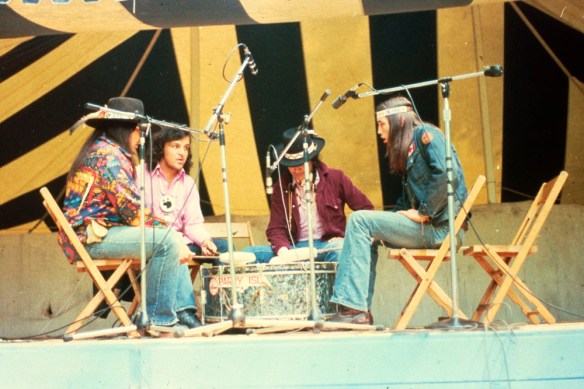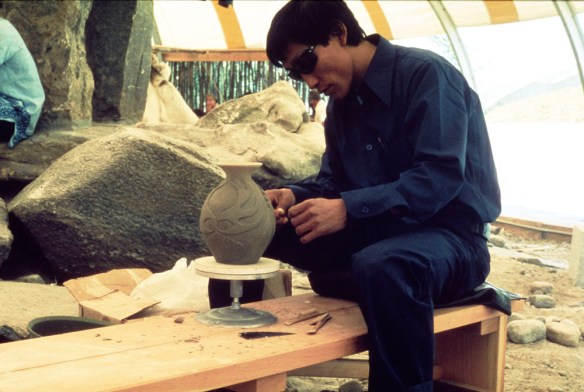This article contains historical language and content that some may consider offensive, such as language used to refer to racial, ethnic and cultural groups. Please see our historical language advisory for more information.
By Annabelle Schattmann
George Mully (1926–1999) was an American playwright and documentary film director. He began as a playwright, working on off-Broadway shows, travelling productions, and operas in the United States and Europe. Mully had various roles, including stagehand, stage manager, lighting designer, and director; he even worked as a puppeteer. After marrying and settling down in England with his wife Ann, Mully pivoted his career from the stage to audiovisual production. He started his own educational production studio, writing, directing, and producing stories on subjects and issues he was passionate about. By 1979, the family had immigrated to Canada and settled in Ottawa.
The George Mully collection, held at Library and Archives Canada, consists of personal and professional documentary photographs taken in the later part of Mully’s career. The images demonstrate his varied interests, including international development, the environment, history and socio-cultural topics, music, and art. In Canada, Mully worked closely with the National Film Board and museums in the capital region, directing many documentary films. Acid from Heaven (1981), a documentary film about acid rain, is a notable work included in his collection.

An Inuk girl with yellow sunglasses, a red jacket, and multicolour mittens. Photo Credit: George Mully (e011218259)
Of particular interest to the We Are Here: Sharing Stories initiative is a series of 363 photographs taken between 1978 and 1988. They depict First Nations people and Inuit from across Canada, as well as Diné (Navajo) and Inde (Apache) from the United States. Mully’s images document how Indigenous people lived and worked in the late 1970s and 1980s. Most of the photographs show people going about their daily lives, often while performing an activity. Sometimes it is a traditional activity, such as hunting, gathering, creating art, and making crafts, or a contemporary activity such as working in a modern industry. Occasionally, Mully captures crossover between traditional and contemporary life.

Four unidentified First Nations drummers performing under a tent. Photo Credit: George Mully (e011218157)
Mully’s interest in human rights is evident in a series of photographs taken in July 1979, when the Indian women’s rights march arrived in Ottawa. The march, led by Maliseet women Sandra Lovelace and Caroline Ennis, protested inequality and discrimination faced by First Nations women who lost their Indian status upon marrying non-status men. Bill C-31 amended the Indian Act in June 1985 by removing the relevant provisions and reinstating status for those affected, among other changes. The revisions to the Act have been critiqued for not adequately addressing the issue.

Unknown individual sitting on the lawn of Parliament Hill in Ottawa with a protest sign. Photo Credit: George Mully (e011218140)
It is not initially clear why Mully captured particular images or what purpose they might have served. Some photographs might have been taken in preparation for a possible documentary or as part of research on a future project. The names of the people depicted, the locations, and the dates of the photographs are unknown; none of the images has a detailed caption, and few textual records accompany the collection. As such, a selection of over 300 photographs will be part of an upcoming Co-Lab challenge and Flickr album. If you recognize someone or a location, or know when an event took place, please go to the George Mully Co-Lab challenge and tag the photographs! Tagging the images with names, locations, and dates will allow others to find images of family members and their communities, and ensure that the people and places are remembered. Thank you for sharing your knowledge, and for your assistance in this endeavour.

Unidentified Inuk artist at an arts event, working on a ceramic vase with an abstract design. Photo Credit: George Mully (e011218140)
This blog is part of a series related to the Indigenous Documentary Heritage Initiatives. Learn how Library and Archives Canada (LAC) increases access to First Nations, Inuit and Métis Nation collections and supports communities in the preservation of Indigenous language recordings.
Annabelle Schattmann is an archival assistant for We Are Here: Sharing Stories, an initiative to digitize Indigenous content at Library and Archives Canada.

![On the left of the graphic, Tatânga Mânî [Chief Walking Buffalo] [George McLean] in traditional regalia on horse. In the middle, Iggi and girl engaging in a “kunik”, a traditional greeting in Inuit culture. On the right, Maxime Marion, a Métis guide stands holding a rifle. In the background, there is a map of Upper and Lower Canada, and text from the Red River Settlement collection.](https://thediscoverblog.com/wp-content/uploads/2019/02/blog-banner.jpg?w=584)
Pingback: George Mully: moments in Indigenous communities — Library and Archives Canada Blog (With Challenge) | Ups and Downs of Family History V2.0